NOTE: This article contains spoilers for Bloodstained: Ritual of the Night and Castlevania: Order of Ecclesia. I’ll be light on the spoilers for Bloodstained… but I will have to reveal the identity of the final boss/finale. You’ve been warned!
 Now let us compare the feminist themes of Bloodstained: Ritual of the Night and Castlevania: Order of Ecclesia.
Now let us compare the feminist themes of Bloodstained: Ritual of the Night and Castlevania: Order of Ecclesia.
In so much as a videogame can have a central “visionary”, we’re going to blame Koji Igarashi for a number of games for which he was writer, director, producer, or all of the above. So let’s produce a list of games credited to IGA…
- Castlevania: Symphony of the Night
- Castlevania: Harmony of Dissonance
- Castlevania: Aria of Sorrow
- Castlevania: Lament of Innocence
- Castlevania: Dawn of Sorrow
- Castlevania: Curse of Darkness
- Castlevania: Portrait of Ruin
- Castlevania: Order of Ecclesia
- Castlevania: The Adventure ReBirth
- Otomedius Excellent: For Some Reason
- Bloodstained: Ritual of the Night
That’s a lot of Castlevania! And, of all those Castlevania games, exactly one game had a solo playable female character. Other than that? Yoko got to stretch her legs in Castlevania: Dawn of Sorrow, but she was permanently tied to an amnesiac and a dhampir. Charlotte was half of the duo of Castlevania: Portrait of Ruin, but there was still no Charlotte (“Charlotte!”) without Jonathan (“Jonathan!”). And what of every other woman in IGA’s Castlevania universe? Well, they’re all either shopkeeps, damsels to be distressed, or literal monsters. The final boss is never a woman (okay, it’s always Dracula, but it’s always a man summoning Dracula), the rival character is never a woman, and a lot of Wallachian women don’t even have walking animations. And that’s pretty depressing, particularly given we were coming off Rondo of Blood, where Maria kicked unholy amounts of ass before being relegated to crushing on Alucard in its (IGA-penned) sequel.
So, suffice to say, one might be forgiven for not having much hope for Shanoa, star of Castlevania: Order of Ecclesia or Miriam, lead of Bloodstained: Ritual of the Night. In fact, it’s entirely possible both of those games are rather disgusting from a feminist (or even just human) perspective, as… Can we take a minute to review how these characters gain new abilities? The stars of many Igavanias simply collected equipment (incidentally, all of these stars were male). Soma of the Sorrow duology gathered souls from defeated monsters, but these souls were happy little wisps that Soma “devoured” while light-headedly puttering around. And the anti-hero of Curse of Darkness forged his own monsters in a proactive manner. Meanwhile, our female leads have to stand around and absorb magical glyphs into their exposed backs (and there’s an odd emphasis in the dialogue on the word “flesh”), or, we’ve got Bloodstained’s…
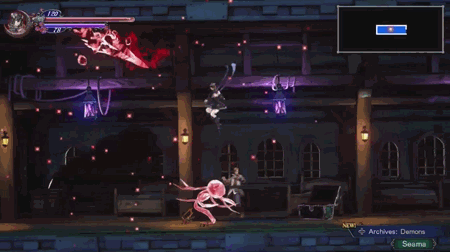
And, just in case you though that little flourish was there for some “horror” graphical curlicue, Miriam elaborates on the feeling of absorbing a shard:
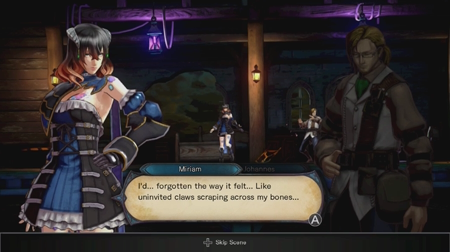
So, congratulations, player! Every time you gain a new skill to advance Miriam on her quest, you are literally torturing her.
That’s… not a great thing to see happen to your female protagonist. It’s an even worse thing when not a single male in the “horror” series suffered violent repercussions for, ya know, amassing powerups.
And, yes, we’re also dealing with worlds where literally every other woman involved in the plot is either a monster or… nonexistent. Shanoa has three other important people in her life: the guy fighting Dracula, the guy reviving Dracula, and Dracula. Miriam at least has one other (adult) woman in the plot, but the finale reveals that she was Dracula (at least She-Dracula) all along. In both cases, there are random female NPCs standing around and dispensing sidequests (so we’re at least on better footing than the first six Star Wars films), but it’s still pretty noticeable that there’s an unmistakable testosterone cloud floating around every character that is actually relevant.
But at least there are catgirl monsters skulking about! There are always catgirl monsters for some reason!
Add it all up, and you would likely expect Order of Ecclesia and Ritual of the Night to be equally abhorrent when it comes to portraying a healthy 51% of the population. But what if I told you that Ritual of the Night is a significant improvement over Order of Ecclesia? Koji Igarashi actually learned something in ten years!
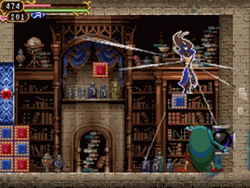 On the surface level, Shanoa of OoE and Miriam of RotN are remarkably similar. In both cases, we are dealing with women that were exploited by “well-meaning” but ultimately demonstrably evil old men. Shanoa was groomed to be a magical conduit/sacrifice to summon Dracula, and Miriam was magically bound to a nasty skin condition to summon forth demons in a marginally successful fundraising campaign (I’m not talking about the kickstarter). Both heroines start their journeys having lost something as a result of old man tampering (Shanoa has lost her memories and emotions, Miriam has lost ten years of her life), and both wind up, one way or another, undertaking their quests as a result of those same damned old men. And, yes, they are both incidentally put through literal Hell in an effort to see their respective endings. It might be fun to play these games, but their respective protagonists are not exactly having the time of their lives.
On the surface level, Shanoa of OoE and Miriam of RotN are remarkably similar. In both cases, we are dealing with women that were exploited by “well-meaning” but ultimately demonstrably evil old men. Shanoa was groomed to be a magical conduit/sacrifice to summon Dracula, and Miriam was magically bound to a nasty skin condition to summon forth demons in a marginally successful fundraising campaign (I’m not talking about the kickstarter). Both heroines start their journeys having lost something as a result of old man tampering (Shanoa has lost her memories and emotions, Miriam has lost ten years of her life), and both wind up, one way or another, undertaking their quests as a result of those same damned old men. And, yes, they are both incidentally put through literal Hell in an effort to see their respective endings. It might be fun to play these games, but their respective protagonists are not exactly having the time of their lives.
Now, technically, there is something feminist happening in both of these stories. As has been noted, while there is a true “final demon” at the end of both of those stories, it seems the real villains of the plot are a cadre of old, wealthy men. Considering it’s one “cursed” young woman against a ruling body of seemingly friendly but actually covertly evil paternal oppressors, you can easily see a moral that maybe the patriarchy doesn’t have everyone’s best interest in mind. However, if you investigate how both stories get to that moral… Well, there’s a bit of a difference here.
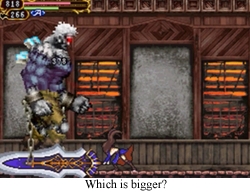 The plain difference between these two stories is the men supporting the women. Miriam has two significant supporting players, Johannes, an alchemist that is continually the Q to Miriam’s Bond, and Zangetsu, a badass ronin warrior that is here to kick demon ass and eat ramen (and he can’t remember which wall contains all his ramen). There is also Gebel, Miriam’s former friend who has now summoned a demonic castle from Hell because it was too complicated to remodel his bathroom. In Shanoa’s case, Gebel and Zangetsu have been essentially merged into one: Albus is the former childhood friend that has goon loony, but he also winds up being the support character that is all-in on destroying the Dracula du jour (which, in this case, is Dracula). There is also Barlowe, who appears to be the prime supporting sidekick (ala Johannes), but is super-duper evil.
The plain difference between these two stories is the men supporting the women. Miriam has two significant supporting players, Johannes, an alchemist that is continually the Q to Miriam’s Bond, and Zangetsu, a badass ronin warrior that is here to kick demon ass and eat ramen (and he can’t remember which wall contains all his ramen). There is also Gebel, Miriam’s former friend who has now summoned a demonic castle from Hell because it was too complicated to remodel his bathroom. In Shanoa’s case, Gebel and Zangetsu have been essentially merged into one: Albus is the former childhood friend that has goon loony, but he also winds up being the support character that is all-in on destroying the Dracula du jour (which, in this case, is Dracula). There is also Barlowe, who appears to be the prime supporting sidekick (ala Johannes), but is super-duper evil.
Barlowe’s sudden but inevitable betrayal is one of the main themes of both games (patriarchy is not to be trusted), but Albus is the real wall meat and potatoes of the plot. Albus is initially introduced interrupting and stealing the dark ritual at the start of the game, and Albus is blamed for Shanoa’s amnesia-based malady. Basically, from the start, he’s presented as the main villain of the piece. This is despite the fact that Barlowe is clearly not operating with everyone’s best interest in mind …
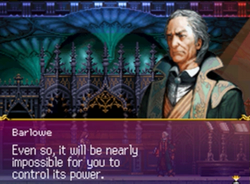
As the adventure progresses, Albus makes it clear that he is toying with Shanoa. It’s all a game of tag, and Albus is “letting” Shanoa win.
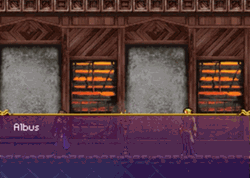
Shanoa literally does not know what to make of this, so she repeatedly notes that she has to consult with Barlowe, her mentor and metaphorical father. All this boy villainy is too much for her little girl brain!
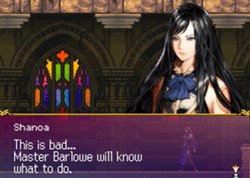
Albus continues to appear to be the bad guy, and even proceeds to drain blood from a few local villagers while Shanoa is left to fight random monsters across the countryside.
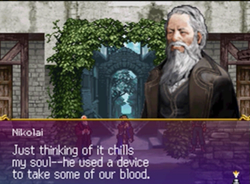
But it turns out to all be a ruse! Albus wasn’t “sucking blood” from villages, he was drawing blood to study the leftover DNA of the famous Belmont clan! And he wasn’t doing that just to further his Bloodborne fanfiction, he was trying to find a way to “tame” the magical spell that Shanoa is fated to use so she doesn’t have to suffer its fatal effects. Albus did everything for Shanoa! His little sister!
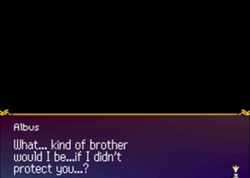
And it works! There are two possible endings at this point in the story: In the one where Albus sees his plan through to the end (partially thanks to Shanoa finding hidden villagers), Shanoa learns the truth of Dominus, and promises Albus she will never use it. In this path, Shanoa confronts Barlowe, learns his evil plan, and lives on to see the true Chateau de Dracula.
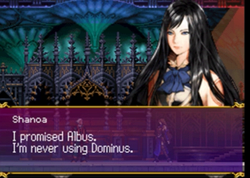
What happens if Albus fails to relay his plan to Shanoa? Well, Shanoa f%^*ing dies.
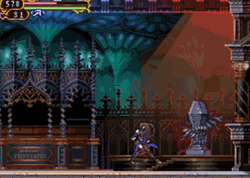
But back to the good ending: Albus dies as part of his plan! He’s a disembodied spirit, and thus must leave Shanoa alone to actually accomplish something and tackle Dracula’s Castle.
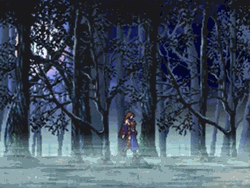
And Shanoa goes on to defeat Dracula! Mostly! Dracula is too much for a woman that is not accompanied by a (male) Belmont, so she is forced to break her promise and use Dominus (because Dracula doesn’t belong in this world). Shanoa uses the forbidden magic, confident that she is going to sacrifice her life in the process…
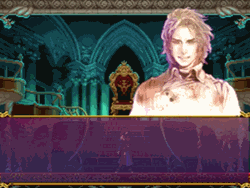
But it turns out Albus was sneaking around Shanoa’s soul the entire time, and he’s going to sacrifice his own spirit so Shanoa will live, and he found Shanoa’s memories and emotions, so everything is right with the world. Albus saved the day! Again! As a ghost! All he asks for is a smile from his little sister, and Shanoa gets a happy ending, all thanks to our hero, Albus!
…
Shanoa sucks, Albus rules. Shanoa beat back the freaking Lord of Darkness and every monster in his castle, but it was Albus that actually accomplished something worthwhile. Shanoa would be dead without Albus. Twice! He saved her life on two separate occasions, because Shanoa, the big dummy, would have otherwise followed her fake dad straight into the grave. Albus questioned and researched and found the true answer, Shanoa was just a mindless cog in the machine.
Ha ha! Girls are stupid, aren’t they!?
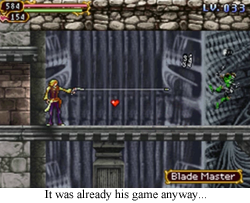 Miriam of Bloodstained might be very similar to Shanoa, but at least she has more agency in her own story. If her Albus really was split into two characters, she still watches both of them die. Yes, both seem to “sacrifice” for her (and Gebel even does that exact same stupid “I just wanted to see you smile” thing), but, in this case, it’s not a matter of “Zangetsu plainly did all of the work” and more “Krillin just took an energy beam for Goku”. Miriam has men falling all over themselves to help her, but she is ultimately the one saving the world. And when the final boss rears its ugly head(s), Miriam is fighting alone, with no boys around to steal the final victory through memory rummaging or bloodletting. Yes, it appears in the final moments that at least one of the men survived to be nobly sacrificed another day, but Miriam’s quest is wholly her own to win or lose. She may be deceived by an ally, or battle against a potential collaborator, but the poor choices she makes over the quest are just as much her choices as those of her comrades.
Miriam of Bloodstained might be very similar to Shanoa, but at least she has more agency in her own story. If her Albus really was split into two characters, she still watches both of them die. Yes, both seem to “sacrifice” for her (and Gebel even does that exact same stupid “I just wanted to see you smile” thing), but, in this case, it’s not a matter of “Zangetsu plainly did all of the work” and more “Krillin just took an energy beam for Goku”. Miriam has men falling all over themselves to help her, but she is ultimately the one saving the world. And when the final boss rears its ugly head(s), Miriam is fighting alone, with no boys around to steal the final victory through memory rummaging or bloodletting. Yes, it appears in the final moments that at least one of the men survived to be nobly sacrificed another day, but Miriam’s quest is wholly her own to win or lose. She may be deceived by an ally, or battle against a potential collaborator, but the poor choices she makes over the quest are just as much her choices as those of her comrades.
Miriam has agency in her own quest. Shanoa is Albus’s unwitting sidekick.
So, yes, both games have their skeevy moments. Both heroines are literally tortured by their own adventures, and both inexplicably can gain transformations into sexy (“sexy”) demons, but there is a very big difference in the agency of their stories. Shanoa is along for Albus’s ride through Castlevania, but Miriam gets to cut her own swath through a murderous castle. It might not be a feminist work for the ages, but it is certainly a step in the right direction.
FGC #443 Castlevania: Order of Ecclesia
- System: Nintendo DS exclusive. We’re kind of due for a Castlevania: Portable collection, aren’t we?
- Number of players: Wasn’t there some kind of trading feature in this one? Or maybe boss rush co-op? Man, these games blend together. Let’s just say single player.
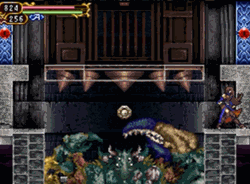 Maybe actually talk about the game for a second: I can never tell if this game is good or not. On one hand, much like Bloodstained, it is fun to “be” Shanoa, and use her many skills and glyphs. Flying around with demon wings and nova skeleton blasts is agreeable. On the other hand, there are so many flat, boring “in-between” levels, and it seems like there’s a lot of cruft at the expense of a more expansive, interesting final castle. I guess this just balances out to a “good” IGAvania, as opposed to a truly great adventure.
Maybe actually talk about the game for a second: I can never tell if this game is good or not. On one hand, much like Bloodstained, it is fun to “be” Shanoa, and use her many skills and glyphs. Flying around with demon wings and nova skeleton blasts is agreeable. On the other hand, there are so many flat, boring “in-between” levels, and it seems like there’s a lot of cruft at the expense of a more expansive, interesting final castle. I guess this just balances out to a “good” IGAvania, as opposed to a truly great adventure.- Favorite Demon: The Jersey Devil makes an appearance! And he’s haunting some kind of bog area! This seems right!
- Most Memorable Boss: Brachyura, the giant enemy crab (this is canonically stated in the game) that haunts the lighthouse, is a roadblock that defines my memories of Shanoa’s adventure. God, I hated that fight. Now that I know everything involved, it’s fairly easy, but I must have failed that battle a thousand times back at release. But I wouldn’t change a thing, as Shanoa shouting “go to hell!” as the crab is finally defeated is massively cathartic. And it’s about the only place in the game where Shanoa displays an actual personality…
- Favorite Boss: Eligor is some kind of giant centaur monster, and I am all about this multipart, Shadow of the Colossus-esque battle. Come to think of it, this battle seems to foreshadow the eventual direction of Castlevania in the Lords of Shadow universe.
- An End: Also, what does Shanoa do after the events of the game? This really does seem to be Albus’s story, as he gets his smile and heroic resolution, and Shanoa… has lost everything and everyone and has no non-vampire-slaying skills to fall back on. I guess she did just inherit an entire monastery…
- Did you know? “Ecclesia” is an actual, not made-up word. It refers to the assembly of people necessary for democracy, and originated back in Ancient Greece. In its initial form, it was, coincidentally enough, only available to men.
- Would I play again: Nah. Bloodstained is here now, and I feel like it and Symphony of the Night will scratch any Castlevania itches for the near future.
What’s next? Random ROB is back to being random, and has chosen… Wait! It’s article #444! Isn’t that creepy…. in Japanese… or something? Yes! I believe it is! We’re going to go with a mysterious, spooky game next! Please look forward to it!
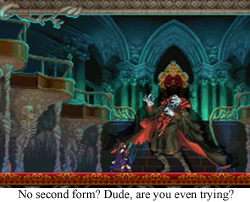

I enjoyed Order of Ecclesia a lot more than the previous DS games (it feels less rushed and recycled* than Portrait and it doesn’t feel like more of the same with an annoying crafting system** duct taped on like Dawn), and I will inevitably pick up the game again around the time I finally play Bloodstained.
But it’s definitely disappointing that that douche Albus steals the show from Shanoa even as a ghost. Guy was a far more interesting character than the lady who’s just there to follow the orders of the secretly evil cult leader and go through the motions of stopping Dracula, and while I’m glad she didn’t die it still kinda sucks that Albus stole the show again even as a ghost.
And what is it with these games and turning strong women into allegedly emotionless*** killing machines? Ladies can both fight demons and not be beep-boop robots!
* Technically all the DS games recycled SotN assets (and SotN itself recycled Rondo and some SC4 assets), but Portrait recycled entire boss fights and a few more of the Rondo assets on top of that. At least Order did a few new things with some of those old assets.
** I am not particularly excited about Bloodstained returning to Dawn’s crafting (and soul hoarding) thing. I highly prefer just finding cool shit laying around the place over having to collect shit to build other shit used to make a third maybe actually good piece of shit.
My opinions on it vary game by game (I’m fine with it in survival games and MonHun), but crafting is way too prevalent in modern games and retraux revivals for my liking. Chrono Trigger is already fine without having to collect 80 Gato recolor shiny metal asses and 50 rocks from that one nigh unkillable DS rock enemy that loves to run away**** to build that ultimate armor!
*** Stoicism is still an emotion, just a boring one.
**** You have to get a rock from one of these bastards if you want Lucca’s new ultimate armor. Other sins the remake committed are an extremely tedious new bonus area you have to go back and forth through time to make incremental progress in and a half-baked monster battle mode with a ton of accessories you can only win randomly that was added solely to give that DS local wireless function a thing to do. The game also has compendiums for everything so it is happy to let you know that you are missing all of that shit.
Oh, and I definitely know about the number 4 in Japanese, so I’ll certainly be anticipating whatever mystery game you’ve chosen for this one. I have a hunch about what it MIGHT be after thinking about it for a while, but I know this could go any number of different ways.
Anyway…
https://imgur.com/z0BxClF
^ My Animal Crossing: New Leaf home layout for Halloween 2013 had four 4 lamps. Also I know the color purple means a similar thing in Japan (Rayman’s outfit is blue over there ‘cuz of that).
Third post in a row, I know, but this FGC was one that seriously interested me so…
I just thought I should mention that you forgot a few playable women in the aforementioned Castlevania games.
1) Stella and Loretta were both playable in Portrait of Ruin, though they were saddled with touch screen gimmicky (right-handed touch screen gimmicky) and their game ends when they get to Brauner and watch their dad die/get turned into vampires. I’d also say they count as the rivals.
2) Maria is also playable in Portrait, but just like Charlotte is a co-protagonist to Jonathan, she is co-protag to Richter (or Richiter as PoR misspelled it). Also they don’t get any semblance of a story and that one enemy who hits on ladies is a creepy pedophile because it’s YOUNG Maria who is playable. =/
3) Maria (Adult this time) is also playable in the PSP port of SotN in Dracula X Chronicles, though of course that game’s stretched to fill a screen and like Richter it’s basically just an arcade mode where you kill shit until Shaft is dead and the castle falls down.
4) The super secret Old Axe Armor character is portrayed as female in official art* and flagged as female in the game, but I’ve no doubt it’s only ‘cuz the Astarte fight would be literally unwinnable if she could charm OAA since they don’t have a sidekick.
Anyway, I apologize if this post comes off as a li’l pedantic. It’s just that women in Castlevania is a topic that greatly interests me and while Portrait was not as good as Bloodstained it did have more female representation than most going for it.
* https://vignette.wikia.nocookie.net/castlevania/images/b/b3/Por_pic_41.jpg/revision/latest?cb=20081025191513
Stella and Loretta were considered… and were what I was thinking of as “literal monsters” in the article. The rest of ’em seem to be entirely non-canon or so deeply hidden it may as well not be a thing.
Which is still a shame! But it’s a “representation” issue similar to, like, a character in a game being technically bi if you kinda squint and take a random comment into a more interesting context. It might count, buuuuuut…
Oh I know. Portrait may have a lot of female presentation in its player roster, but power-up torture aside I know Bloodstained: Ritual of the Night does (comparatively) much better with its one female protagonist.
In the main plot Stella and Loretta are just flunkies for a (male) vampire who killed their dad and turned them before the game started, and after fixing that they do literally nothing but sit around and offer to let you go throw pies at Richter to make that Vampire Killer not suck for your Morris blooded ass. You know, if you want to.
I mean, Jonathan’s got an Alucard’s worth of weapon variety compared to previous Metroidvania whip headliners like the “use rock on whip” Juste Belmont and non-canon/non-IGA magical card reliant Nathan Graves, and like Trevor Belmont centuries ago he was smart enough to bring a friend. He doesn’t actually need a powered up whip that will gradually kill his non-Belmont ass like it did his dad.
Speaking of his friend, Charlotte can definitely be useful when she has room to charge up a screen-clearing spell before the enemies can get to her, and she’s vital for turning the girls back and defeating Astarte and her charm spell and any life-and-death situations requiring two people, but a lot of the time she definitely feels…lesser compared to her partner.
Jonathan gets a pile of whips, swords, spears, axes, knives, and knuckles, along with exclusive mobility and utility boosting moves and a pile of sub-weapons that grow stronger with use. Charlotte gets a few books and a pile of situational spells that are most effective when you have the time to stand around and charge them.
What I’m saying is Johnny boy is a lot more suited for just tearing through the castle than Charlotte is.